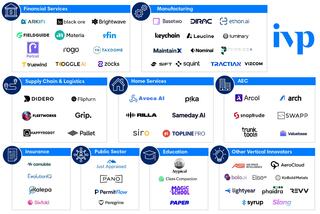The mantra for Vertical SaaS, defined in the last decade by the success stories of companies like Shopify, Toast, and Procore, has long been growing with customers through expanded product offerings to become an entrenched operating system. Underlying this emphasis on the “layer cake” strategy is the fundamental “concern” that plagues vertical-focused businesses – simply, a company’s TAM is often deemed too small to support a “venture-sized outcome”. To compensate for lack of capturable breadth, product expansion to capture more depth of customers becomes paramount.
How is Vertical AI different? The rise of LLMs has shown that labor – whether categorized as internal headcount spend or outsourced services spend – can not only be aided by software solutions, but can also be replaced, particularly where repetitive processes are involved. Of course, not all types of work in all verticals can be automated. Point being, the magnitude of labor spend vs. software spend in the U.S. – the pie chart of which we’ll spare you – is notable.
In contrast to traditional seat-based software, Vertical AI is enabling a fundamental change in cost structures and is delivering measurable value in novel ways, translating to higher willingness to pay from customers, which ultimately translates to a larger baseline TAM.
Our conversations with buyers and decision-makers in key vertical markets have shown that while the immediate use cases for Vertical AI solutions have been clear time/cost-saving initiatives, many businesses view this new wave of AI software as a way to differentiate amidst competitive industries and strengthen relationships with end customers. As AI adoption has transitioned from escapism and entertainment to business experimentation, to utility, traditionally underserved industries are more likely to adopt solutions that provide clear ROI, and fast time to value. What are the different wedges we’re seeing?
Cost & Efficiency Optimization
While the churn rates for AI products have been higher than traditional SaaS over the past couple of years, Vertical AI startups have, on average, stronger retention rates than their horizontal counterparts — mostly because they’re focused on making the expensive, time-consuming manual processes cheaper and more efficient. Just a few examples include:
- F500 industrial companies are saving weeks and hundreds of engineering hours on initial design and simulation of new products (think wind turbines and automobiles)
- Top 10 insurance companies are accelerating the review process for millions of claims, using AI software to help claims examiners sort through myriad sources of data
- Global manufacturing firms are using AI hardware + software to accurately predict equipment maintenance requirements and to ensure uptime, saving tens of millions of dollars in equipment service costs
Incremental Revenue Generation
Beyond saving money, Vertical AI tools are also helping companies generate additional revenue by driving higher utilization, automating the sales funnel, and analyzing data to make sales more efficient. Worth reiterating here is the vast amount and variety of data that can now be collected and analyzed with LLMs – from field sales conversations to security camera feeds to unstructured customer feedback across different channels, companies can use these data sources to improve sales efficiency and sell new offerings to their customers.
- Some of the largest quick-service restaurant chains in the country are using AI to take customers’ orders in the store and in drive-thrus, leading to higher order throughput and average order value (AOV)
- Enterprise and midmarket home services companies have increased conversion rates and average ticket sizes by 25% by leveraging AI and analytics from offline conversations
- Major ecommerce brands are using AI to more accurately predict inventory, prevent their bestselling products from going out of stock, and dynamically optimize prices
Improved Customer Experience
Traditionally, when a company tries to optimize efficiency, there is a negative impact on the customer experience — with longer wait times, less personalization, and a less ambitious road map. Done right, Vertical AI can actually improve the customer experience — with better insights, personalization at scale, and the ability to resolve edge cases quickly.
- Schools and educators are leveraging AI to personalize the learning experience for students, creating lesson plans, assessments, and IEPs based on individual student needs and learning preferences
- Architecture firms are accelerating the building design process while enabling a more collaborative, iterative process with clients, using AI design tools that generate real-time feedback on project cost, compliance, and climate
Companies Leading the Charge
Below are a few sectors we view as exciting opportunities for AI innovation:

We’re just beginning to see the value that AI can provide in vertical markets. But the ways in which AI is already making companies more efficient, helping them generate more revenue, and improving the customer experience, makes us excited to partner with founders who are leading the charge.
If you’re building a Vertical AI business, reach out to us at kramakrishnan@ivp.com and ckuo@ivp.com. We’d love to hear from you.
